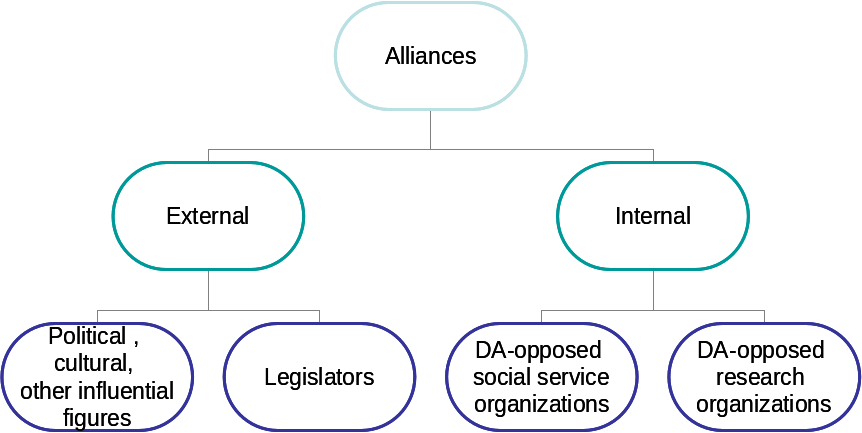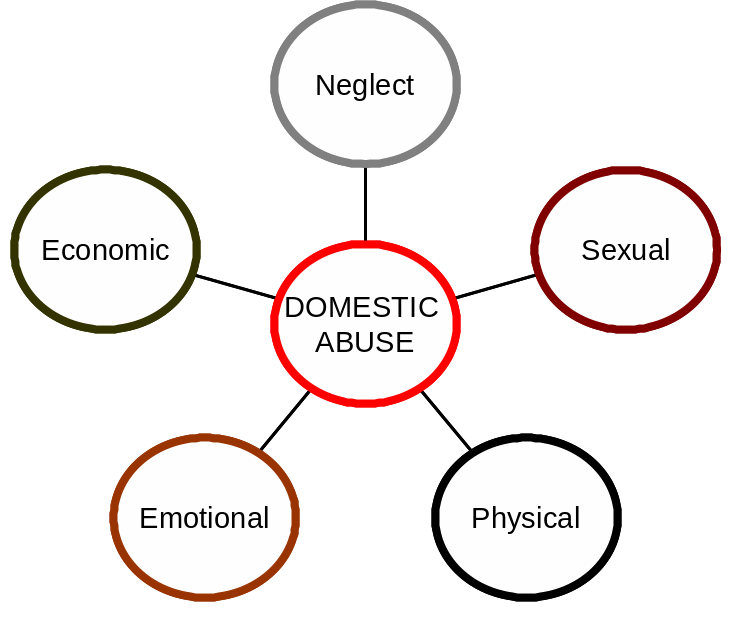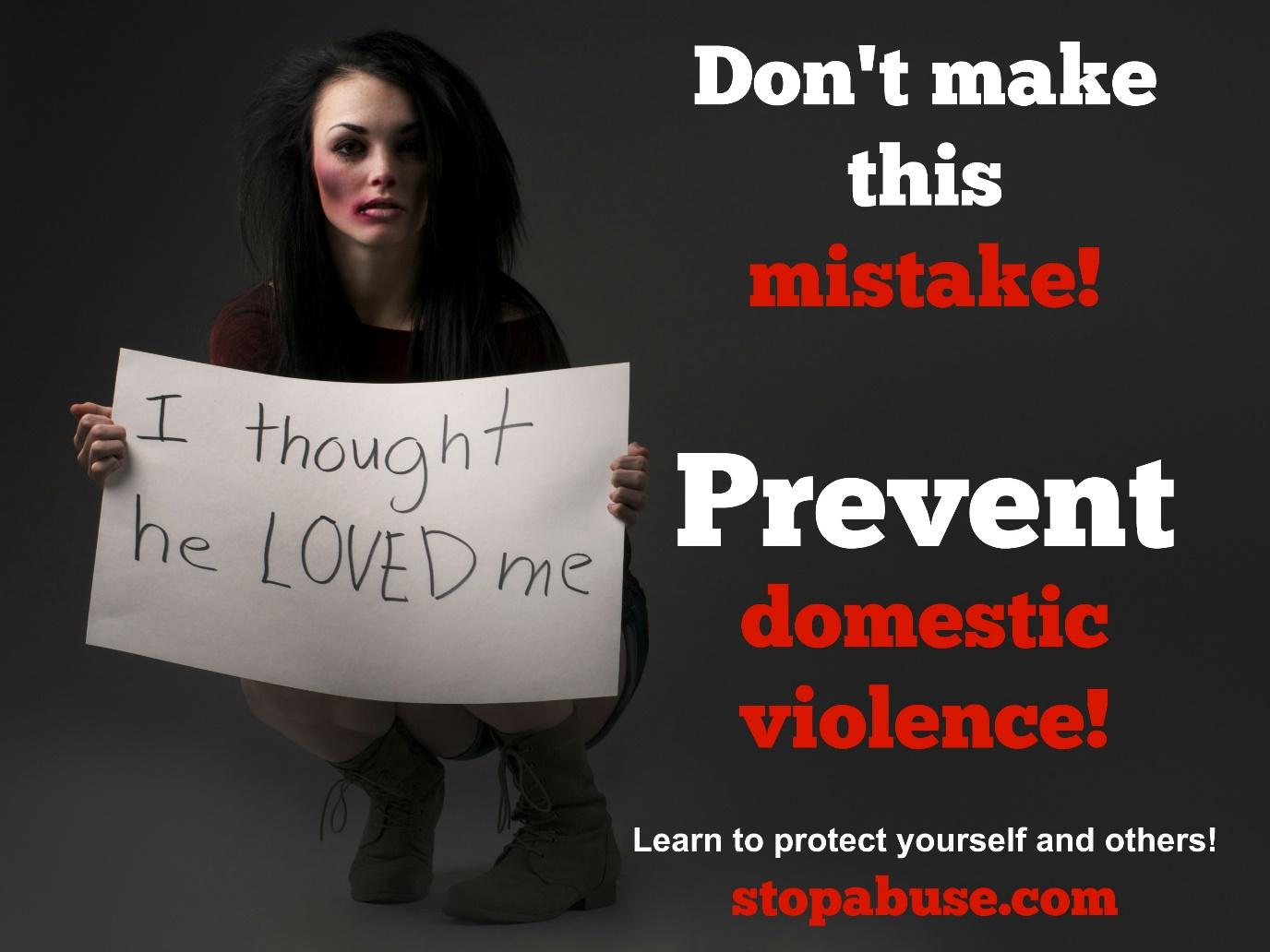Introduction
The presented advocacy initiative stems from the campaign carried out by the Canadian Association for Equality (n.d.), which is aimed at attracting public attention to violence against men. It is suggested to advocate for a non-discriminatory approach to domestic violence and abuse (DA) victims promoted with the help of a healthy relationship (HR) education. The recent event that prompted the proposed advocacy is the criticism of a banner that depicts a man as the victim of abuse. It indicates that society denies the fact that various groups can be victimized (Reddekopp, 2015). Therefore, the goals of the advocacy include education, public opinion formation, and the educational policy changing.

Environmental Scan
Key Decision Makers. Internal and External Alliances
As Figure 1 shows, family violence is regulated by the Canadian federal legislation that is complemented by the territorial and provincial ones in most provinces. All the provinces and territories have specific laws for child protection (Department of Justice, 2015a). The victims receive help from police and local victim services (629 agencies), hospitals and religious organizations, and personal doctors and nurses (Department of Justice, 2015b). The research on abuse is supported by the Alliance of Canadian Research Centres on Violence (The Centre for Research and Education on Violence against Women and Children, 2015). In other words, the issue is being addressed through governmental and non-governmental efforts.
Canadian Women’s Foundation (2015) promotes advocacy for the rights of female victims, and the Canadian Association for Equality (n.d.) has recently been involved in advocating for male victims. These agencies can help to form internal alliances with respect to the issue. External supportive figures include the majority of politicians; for example, Purdy mentions Maria Fitzpatrick as a politician who had been in an abusive relationship and is now advocating against it. Figure 2 illustrates the potential alliances.

Barriers to Change
The problem of DA persists. According to the Canadian Centre for Justice Statistics (2015), in 2013, 87,820 people in Canada were victims of family violence, with 68% of them being female (p. 4). The barriers to the continued solution of the issue are the misconceptions related to relationships, especially those based on stereotypes. For example, sexist stereotypes are harmful to women and men: for the former, they increase the risk of abuse, and the latter are less likely to ask for and receive help (Canadian Association for Equality, n.d., para. 9-10).
Such stereotypes will be addressed by the educational efforts of the advocacy. Apart from that, the initiative presupposes HR education for children, and parents’ approval will be necessary for that. Here, a consistent explanation of the nature of proposed instruction and evidence of its effectiveness will be used to bring the potential barrier down.
Pressure Points
Several pressure points or “windows for an opportunity” can be identified. The research and evaluation of educational programs presented, for example, by the Canadian Women’s Foundation (2011; 2012) can be regarded as an opportunity to provide the evidence to these programs being feasible. The alliance with research organizations ensures a similar advantage. The emergence of the advocacy that focuses on male victims provides the opportunity of creating a comprehensive initiative through the alliance with it.
However, this fact is also likely to provide the “reverse” pressure point: the criticism of the attempts at shifting the focus toward male victims can be encountered (Reddekopp, 2015). Such criticism will be logically countered: while the distinct approaches are justified by the specific needs of people of different ages and sex, they are less crucial when the prevention (educational) measures are discussed: everyone needs HR education. Also, victim distinction should not lead to discrimination, especially when education is concerned.
Power Relations
The power relations (political, legislative) are generally in favor of the advocacy, but there are limitations. Not all the types of DA are paid due attention: the emphasis is typically placed on women and children, which is explained by the fact that they are more vulnerable, but also may lead to discrimination in this respect.
Research and the Root Cause of the Issue

DA is defined by the Canadian Family Violence Initiative as “…a range of abusive behaviors that occur within relationships based on kinship, intimacy, dependency or trust” (as cited in Canadian Centre for Justice Statistics, 2015, p. 6). Figure 3 presents its forms. The economic impact of only one type of DA (spousal) is estimated to amount to $7.4 billion per year (Department of Justice, 2015, para. 85).
As stated above, Canada has an extensive legislative and social service basis to fight against DA, but it is a persistent issue. The root of such persistence is likely to lie in the similarly long-living misconceptions. For example, the Canadian Women’s Foundation (2015) posted the results of its survey, according to which 1 in 10 Canadians do not believe that sexual consent is needed for sex in marriage or long-term relationships (Canadian Women’s Foundation, 2015, par. 1).
Also, the belief in the necessity of “keeping family together” can prevent a woman from leaving an abuser (Canadian Women’s Foundation, 2015, par. 5). With men, similarly harmful misconceptions can be encountered. Men are, on average, less likely to be subjected to DA than women or children, but they are also much less likely to use formal help (Canadian Association for Equality, n.d., para. 9-10).
Reddekopp (2015) describes the debate prompted by the billboard that depicts a man as a victim of verbal abuse. The fact that it has raised criticism indicates that this kind of abuse still requires acknowledgment. To sum up, there is still much to be done to help all the parts of the affected population, and it is noteworthy that relevant education has the potential of helping male and female victims learn about their condition and opportunities to solve the problem (Fredland, 2010).
Relevant educational programs aimed at children and teenagers have been developing for about thirty years (Canadian Women’s Foundation, 2012, p. 10). Such programs produce a number of outcomes, including the knowledge of the dynamics of healthy and unhealthy relationships and the building of various skills, including critical thinking and emotion management (Canadian Women’s Foundation, 2011; Canadian Women’s Foundation, 2012).
As a result, these programs have the potential of empowering youngsters, which is known to contribute to the solutions of multiple issues of modern society (Chinman & Linney, 1998). New creative approaches to HR education are being developed: for example, the theater program for 7th-grade students described by Fredland (2010). Similar education initiatives exist for grown-up people who experience problems in their marriages, but the latter is admittedly an intervention rather than a prevention measure (Ditzen, Hahlweg, Fehm-Wolfsdorf, & Baucom, 2011). In the proposed advocacy, the preventive measure of education is emphasized, and it is pointed out that the socially prevalent tendency to distinguish (and possibly discriminate) victims is unacceptable for child and youth HR programs.
Costs
The advocacy is most likely to involve volunteers at its initial stage that presupposes the policy submission and public education. At best, the costs will be limited to the production of flyers (from $2-3 per unit given the amounts) and posters (depending on the type, materials, and placement) and possibly website maintenance (the price varies greatly, but about $500 yearly can be expected). The personal costs for the advocates, in this case, will be impressive and will include the time and effort spent and the psychological strain connected to them. It is rather unlikely that the costs will include damage to relationships or reputation, but the issue of personal relationships with abusers may arise for some of the participants.
As the campaign progresses, greater possibilities can be explored, and greater expenditures may be needed.
Public Education Initiatives
According to Ezell (2001), “effective advocates should always think about framing their issue, influencing public opinion” (p. 121). Several strategies will be used for that. Given the fact that the modern world is becoming increasingly technology-savvy, a website or web page for the initiative is a must.
A project of a flyer commercial for the project can be found in Figure 4. For the campaign itself, the flyers, and possible video a similar strategy will be used: emotionally appealing visuals, the call to action, and the emphasis on education as a solution for DA. It is important that the images should promote a non-discriminatory approach: there should be variants for different groups. An example of the speech is proposed below. It is also supposed to be emotionally appealing and focusing on education as a way of resolving the issue.

Also, engaging youngsters in the initiative as volunteers can be regarded as an educational initiative that serves multiple purposes. Apart from educating them, such an approach provides the opportunity for empowering youngsters by offering them to take up new roles and participate in activities that will help them to build leadership, teamwork, and even creative skills (Chinman & Linney, 1998). Given the fact that the educational approach to DA problem solution targets youngsters, primarily, their involvement is a logical strategy for both public education and staffing.
Speech
The issue of domestic violence and abuse is one of the most disconcerting, gruesome, and persistent problems in Canada and all over the world. Our country has over 600 agencies that work with the victims, and our legislation is being constantly revised and improved to ensure our protection, but it just does not seem to be enough. When two tragic deaths of women took place in Winnipeg in 2015 as a result of domestic abuse and difficulties in attaining and maintaining protection order, the legislation of the province was improved to avoid similar issues.
In other words, the government responds when it can and however it can, and it has the necessary resources that we, citizens, do not have. And yet, we can contribute and contribute greatly to the resolution of this problem by learning and teaching our children what proper relationships is. Building relationships – with your partner or parent or child, with a male or a female – is not as simple as it seems; in fact, it is an art, one that we can and should study and perfect. We need to learn patience and acceptance; we need to banish stereotypes that still prevail in our society. We need to fight domestic violence – for the sake of ourselves and those who we love.
Political Agenda
Political advocacy is necessary to achieve the ultimate goal of the initiative: the development of policies and recommendations aimed at promoting the introduction of non-discriminatory HR education among Canadian youth. Ezell (2001) points out the importance of monitoring the political situation and political figures: it is likely that “windows for opportunities” may open there. The targeted conversation that is aimed at “heartstrings or purse strings” can be initiated with the help of letters and e-mails and may proceed in a similar fashion (Ezell, 2001, p. 81). The political agenda may begin with targeting the local legislators and move over to the federal ones (see Figure 1).
Policy Submission Format
The advocacy needs to attempt to reach both the political figures, legislators, bureaucrats, and the wide audience. The former can be targeted directly via e-mails, letters, or faxes. These types of policy submissions need to be clear, business-like, well-founded and provide the information concerning the suggested strategies and expected outcomes. They should contain the emotional component, but the persuasive element, in this case, is facts. With the latter, media can be contacted (once again, via letters and e-mails).
These policy submissions can be more emotional and may skip some of the implementations details, but they still need to present a clear image of what is being done. These submissions are “digestible,” as put by Ezell (2001): that is, understandable to the general public (p. 58).
Potential Outcomes
The intermediate outcome will consist in the attraction of the public attention to the need for DA and HR education with respect to different parts of the population, including the unconventional type of victim: the males. The eventual potential outcome of the advocacy consists of developing the acknowledgment of the need to introduce (for policy and structural levels) and take (at the personal level) non-discriminatory HR education. The actual creation of suitable educational policies on the higher levels might is the eventual, most ambitious goal.
References
Canadian Association for Equality. (n.d.). Violence against men. Web.
Canadian Centre for Justice Statistics. (2015). Family violence in Canada: A statistical profile, 2013. Web.
Canadian Women’s Foundation. (2011). Healthy relationships: Preventing teen dating violence. Web.
Canadian Women’s Foundation. (2012). An overview of school-based healthy relationship programs. Web.
Canadian Women’s Foundation. (2015). The Facts About Violence Against Women. Web.
Centre for Research and Education on Violence against Women and Children. (2015). Partners. Web.
Chinman, M.J. & Linney, J. A. (1998). Toward a model of adolescent empowerment. Theoretical and empirical evidence. The Journal of Primary Prevention, 18(4), 393-413.
Department of Justice. (2015). About family violence. Web.
Department of Justice. (2015a). Family violence laws. Web.
Department of Justice. (2015b). Get help with family violence. Web.
Ditzen, B., Hahlweg, K., Fehm-Wolfsdorf, G., & Baucom, D. (2011). Assisting couples to develop healthy relationships: Effects of couples relationship education on cortisol. Psychoneuroendocrinology, 36(5), 597-607. Web.
Ezell, Mark (2001). Advocacy in the Human Services. Belmont, CA. Wadsworth/Thomson Learning.
Fredland, N. M. (2010). Nurturing healthy relationships through a community-based interactive theater program. Journal Of Community Health Nursing, 27(2), 107-118. Web.
Purdy, C. (2015). Domestic violence laws change across Canada following horrific year. The Huffington Post. Web.
Reddekopp, L. (2015). Domestic violence against men target of controversial campaign. CBC News. Web.